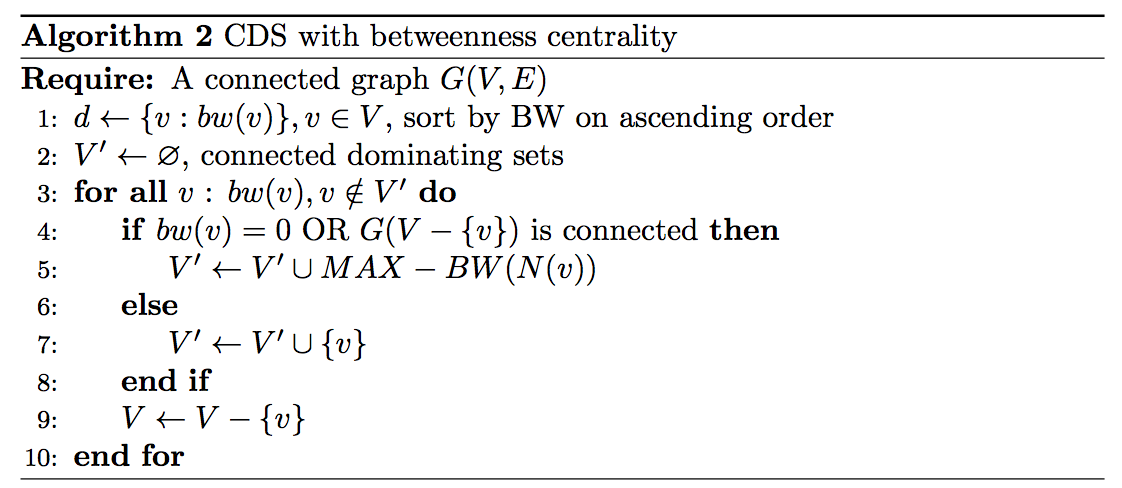This article presents two notable algorithm typesetting environments: algorithmic and algorithmicx with illustrated examples.
1. Overview
LaTeX has several packages for typesetting algorithms in form of pseudocode. There are four notable packages: algorithmic, algorithmicx, algorithm2e and program[1]. In a nutshell[2],
- algorithm - float wrapper for algorithms (provide a floating environment for algorithms).
- algorithmic - algorithm typesetting environment.
- algorithmicx - algorithm typesetting environment.
- algpseudocode - layout for algorithmicx.
- algorithm2e - algorithm typesetting environment.
- program - algorithm typesetting environment
The package algorithmicx is like algorithmic upgraded. algorithm2e is an environment for writing algorithms in LaTeX2e. It allows typesetting algorithms with a lot of customization.
2. algorithm
The algorithm environment provides a floating environment for algorithms. It enables to wrap around algorithms to avoid it being split over pages.
\begin{algorithm}
\caption{Algorithm caption}
\label{alg:algorithm-label (for references later in your document)}
\begin{algorithmic}
...pseudocode...
\end{algorithmic}
\end{algorithm}
Other useful features are below.
% Algorithm numbering
\usepackage[chapter]{algorithm} % part, chapter, section, subsection, subsubsection or nothing (default)
% List of algorithms
\listofalgorithms
% Change the name of the label Algorithm
\floatname{algorithm}{算法}
\makeatletter
\renewcommand{\ALG@name}{算法}
\makeatother
% Rename require/ensure to input/output:
\renewcommand{\algorithmicrequire}{\textbf{Input:}}
\renewcommand{\algorithmicensure}{\textbf{Output:}}
3. algorithmicx
3.1 An example
Put \usepackage{algpseudocode} (algorithmicx will be loaded automatically) in the preamble to use the algorithmic environment. Here is a minimum working example.
\documentclass{article}
\usepackage{algorithm} % float wrapper for algorithms.
\usepackage{algpseudocode} % layout for algorithmicx
\usepackage{amsmath} % AMS mathematical facilities for LATEX
% Nice looking for empty set
\usepackage{amssymb} % provides an extended symbol collection
\let\oldemptyset\emptyset
\let\emptyset\varnothing
\begin{document}
% algorithm
\begin{algorithm}
\begin{algorithmic}%[1]
\caption{CDS with betweenness centrality} \label{algorithm: cds bw}
\Require A connected graph $G(V, E)$
\State $d \gets \{v : bw(v)\}, v \in V$, sort by BW on ascending order
\State $V' \gets \emptyset$, connected dominating sets
\ForAll{$v$ : $bw(v), v \notin V'$}
\If{$bw(v) = 0$ OR $G(V-\{v\})$ is connected}
\State $V' \gets V' \cup MAX-BW(N(v))$
\Else
\State $V' \gets V' \cup \{v\}$
\EndIf
\State $V \gets V-\{v\}$
\EndFor
\end{algorithmic}
\end{algorithm}
\end{document}
which produces,
 Fig. 1: An example of pseudocode produced by algorithmicx
Fig. 1: An example of pseudocode produced by algorithmicx
3.2 Basic commands
Basic commands are,
% Pre- and postcondition:
\Require <text>
\Ensure <text>
% Functions
\Function{<name>}{<params>} <body> \EndFunction
\Return <text>
\Call{<name>}{<params>}
% Statement (\State causes a new line, can also be used in front of other commands)
\State $x\gets <value>$
% Comments:
\Comment{<text>}
% Three forms of if-statements
\If{<condition>} <text> \EndIf
\If{<condition>} <text> \Else <text> \EndIf
\If{<condition>} <text> \ElsIf{<condition>} <text> \Else <text> \EndIf
% Loops:
\For{<condition>} <text> \EndFor
\ForAll{<condition>} <text> \EndFor
\While{<condition>} <text> \EndWhile
\Repeat <text> \Until{<condition>}
\Loop <text> \EndLoop
4. algorithmic
4.1 A minimum working example
The above example is adapted for algorithmic.
\documentclass{article}
\usepackage{algorithm} % float wrapper for algorithms.
\usepackage{algorithmic}
\usepackage{amsmath} % AMS mathematical facilities for LATEX
% Nice looking for empty set
\usepackage{amssymb} % provides an extended symbol collection
\let\oldemptyset\emptyset
\let\emptyset\varnothing
\begin{document}
% algorithm
\begin{algorithm}
\begin{algorithmic}%[1]
\caption{CDS with betweenness centrality} \label{algorithm: cds bw}
\REQUIRE A connected graph $G(V, E)$
\STATE $d \gets \{v : bw(v)\}, v \in V$, sort by BW on ascending order
\STATE $V' \gets \emptyset$, connected dominating sets
\FORALL{$v$ : $bw(v), v \notin V'$}
\IF{$bw(v) = 0$ OR $G(V-\{v\})$ is connected}
\STATE $V' \gets V' \cup MAX-BW(N(v))$
\ELSE
\STATE $V' \gets V' \cup \{v\}$
\ENDIF
\STATE $V \gets V-\{v\}$
\ENDFOR
\end{algorithmic}
\end{algorithm}
\end{document}
4.2 Basic commands
The algorithmic package (use all capital letters) uses a similar set of commands as the algorithmicx package (capitalize the first letter). Basic commands are:
\REQUIRE <text>
\ENSURE <text>
\STATE <text>
\COMMENT{<text>}
\IF{<condition>} \STATE {<text>} \ELSE \STATE{<text>} \ENDIF
\IF{<condition>} \STATE {<text>} \ELSIF{<condition>} \STATE{<text>} \ENDIF
\FOR{<condition>} \STATE {<text>} \ENDFOR
\FOR{<condition> \TO <condition> } \STATE {<text>} \ENDFOR
\FORALL{<condition>} \STATE{<text>} \ENDFOR
\WHILE{<condition>} \STATE{<text>} \ENDWHILE
\REPEAT \STATE{<text>} \UNTIL{<condition>}
\LOOP \STATE{<text>} \ENDLOOP
\RETURN <text>
\PRINT <text>
\AND, \OR, \XOR, \NOT, \TO, \TRUE, \FALSE
PS: The related source code is shared on my GitHub, here.
References:
[1] Wikibooks: LaTeX Algorithms
[1] TeX - LaTeX: algorithm, algorithmic, algorithmicx, algorithm2e, algpseudocode = confused
[2] 博文:LaTeX/Algorithms 伪代码
[3] TeX - LaTeX: What does each AMS package do?